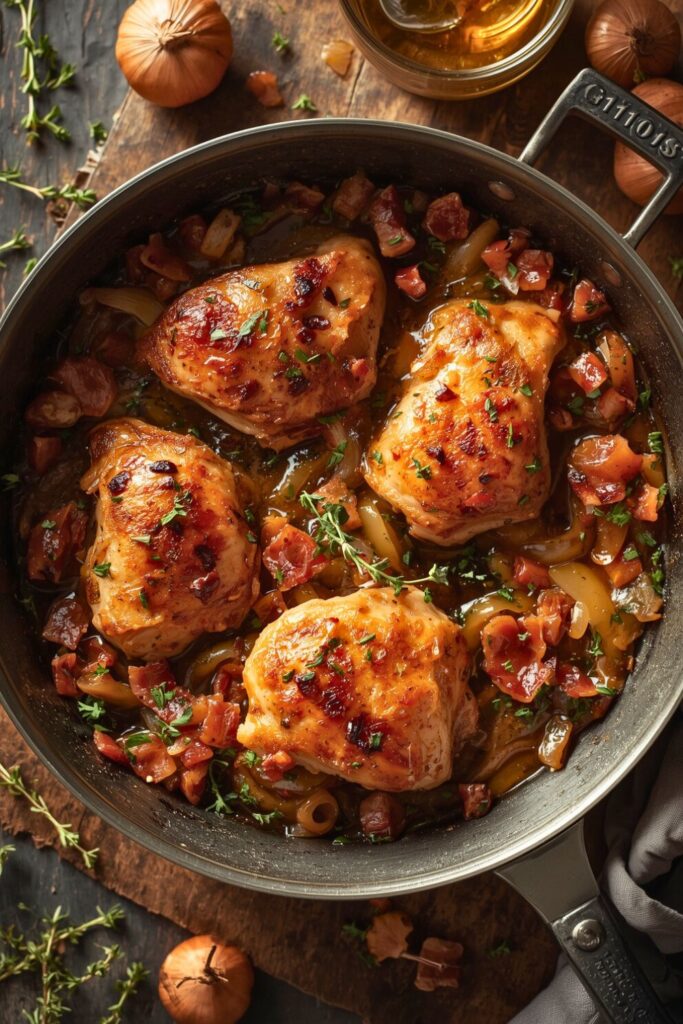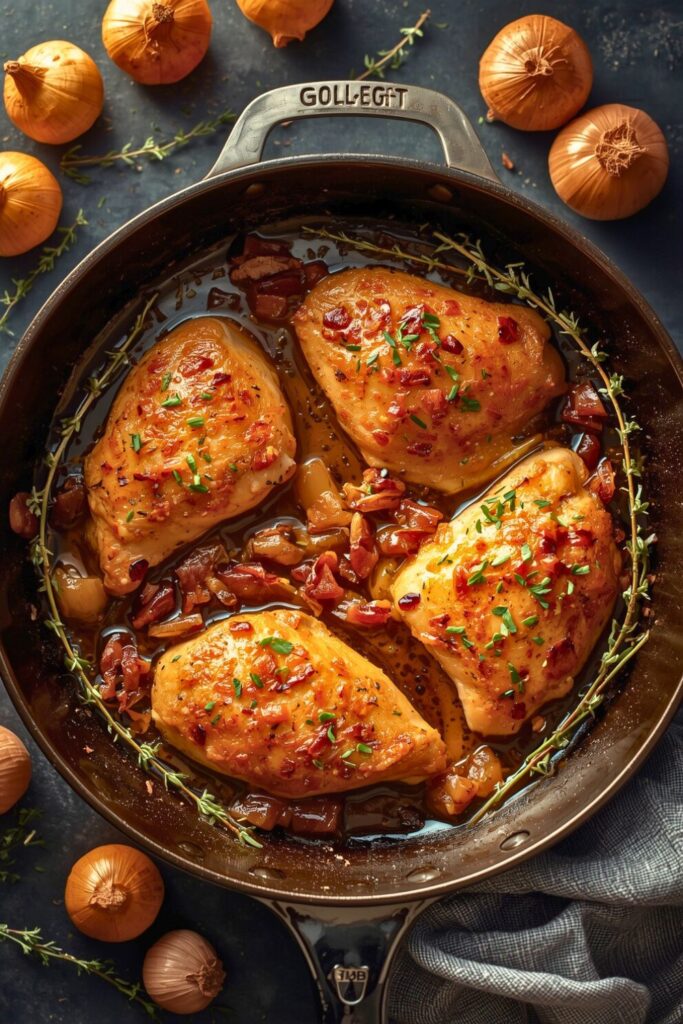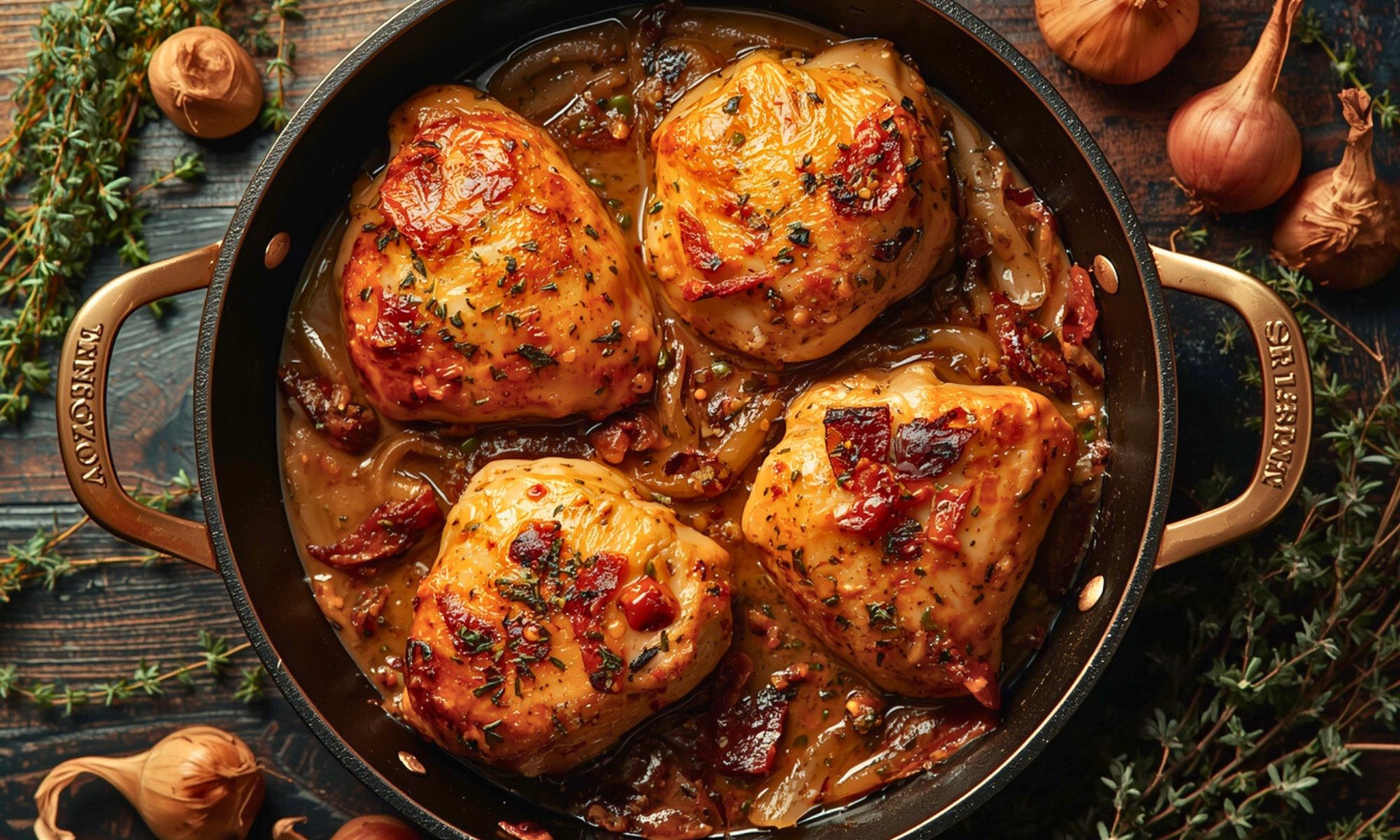Dinner doesn’t wait for perfect plans, it crashes in when you’re running on fumes, daring you to make magic with whatever’s left behind. That’s exactly how this Savory Chicken Fricassee with Crispy Bacon and Caramelized Shallots was born in my kitchen.
A couple of forgotten chicken thighs, bacon that begged to be cooked, and shallots that turned into caramelized gold, suddenly, chaos shifted into comfort, filling the air with a buttery, garlicky aroma that clung to the walls and made the whole night feel warmer than it started.
The pan sizzled, the sauce bubbled, and before I knew it, I had a dish that tasted way more intentional than my mood at the time. Bold, savory, and just indulgent enough, it’s the kind of recipe that rescues tired nights without feeling like a shortcut, transforming pantry scraps into something memorable, soulful, and worth repeating..
Why This Chicken Fricassee Changes Everything

Traditional fricassee can be… well, let’s be honest, pretty boring. White sauce, bland chicken, vegetables that taste like they gave up on life. But here’s where we flip the script completely.
The bacon isn’t just an add on, it’s our flavor foundation. We render it slowly until those edges get crispy and dark, creating little pockets of concentrated umami that’ll make your taste buds sing. The rendered fat becomes our cooking medium, infusing everything that touches the pan with that smoky essence.
And those shallots? They’re not just onions’ fancy cousin. When you caramelize them properly, they transform into something almost jam like, sweet and complex with hints of garlic and a depth that regular onions simply can’t match. It’s like upgrading from economy to first class, technically the same category, but worlds apart in experience.
Comfort Food, Elevated With Skill
What makes this fricassee special isn’t just the ingredients, it’s how we treat them. We’re using classical French techniques but keeping things approachable. No need for specialty equipment or ingredients you’ll use once and forget about.
The key is patience. Real caramelization can’t be rushed, and proper fricassee development takes time. But don’t worry, most of it’s hands off time where you can prep other things or pour yourself a glass of wine and enjoy the incredible aromas filling your kitchen.
Essential Ingredients for Chicken Fricassee Success
Let’s talk about what you need, in the order you’ll actually use them, because who has time for alphabetical ingredient lists when you’re cooking?
For the bacon base:
- 6 thick cut bacon slices (thick cut is crucial here, thin bacon burns before it properly renders)
- 8 medium shallots, sliced thin (about 2 cups once sliced)
- 2 tablespoons butter (European style if you’ve got it)
For the chicken:
- 3 pounds bone in, skin on chicken thighs (trust me on the thighs, they stay tender)
- 1/2 cup all purpose flour (for dredging)
- Salt and fresh cracked black pepper
- 2 teaspoons fresh thyme leaves (dried works, but fresh is magic)
- 1 bay leaf
For the sauce:
- 1/2 cup dry white wine (nothing you wouldn’t drink)
- 2 cups quality chicken stock
- 1/2 cup heavy cream
- 2 tablespoons fresh parsley, chopped
- 1 tablespoon Dijon mustard (the good stuff, not yellow)
Smart swaps for different needs
Got dietary restrictions? No problem. Use turkey bacon if you’re avoiding pork, it won’t have quite the same richness, but it’ll still work beautifully. Lactose intolerant? Swap the cream for full fat coconut milk, but add it at the very end and don’t let it boil or it might separate.
Can’t find shallots? Yellow onions work, but use about half the amount since they’re stronger. The flavor profile changes slightly, less subtle, more assertive, but still delicious.
Ingredient selection secrets
When picking chicken thighs, look for ones that feel firm and have skin that’s not slimy. The bone keeps the meat moist during cooking, and the skin renders into crispy goodness that adds texture.
For bacon, thickness matters more than brand. You want pieces that’ll hold their shape and provide substantial bites, not disappear into bacon bits.
Fresh thyme makes a noticeable difference here. If you’re using dried, use about half the amount, and add it earlier in the cooking process so it has time to rehydrate and bloom.
Step by Step Fricassee Mastery

Step 1: Build your bacon foundation
Start with a cold, heavy bottomed pan, cast iron or enameled Dutch oven works perfectly. Lay those bacon slices in without overlapping and turn the heat to medium low. This is where patience pays off big time.
Let them render slowly, maybe 8-10 minutes, turning once halfway through. You want them golden and crispy but not burned. The slow rendering extracts maximum fat while keeping the bacon tender inside those crispy edges.
Remove the bacon to a paper towel lined plate, but leave all that gorgeous fat in the pan. That’s liquid gold right there.
Step 2: Caramelize those shallots like a pro
Keep the heat at medium low and add your sliced shallots to that bacon fat. This is where the magic happens, but it can’t be rushed.
Stir them occasionally, every 3-4 minutes, letting them slowly turn from raw and sharp to golden, then deep amber. The whole process takes about 15-20 minutes, and you’ll know they’re ready when they’re jammy and sweet, with deep caramelized edges.
Common pitfall alert: If they’re browning too fast, your heat’s too high. Burned shallots are bitter, and there’s no coming back from that. Low and slow wins the race here.
Add that butter in the last minute of cooking, it adds richness and helps prevent any sticking.
Step 3: The chicken gets the royal treatment
Pat those chicken thighs completely dry with paper towels. Season them generously with salt and pepper, more than you think you need. Dredge them lightly in flour, shaking off any excess.
Push the shallots to one side of your pan and increase heat to medium high. Sear the chicken skin side down first, about 4-5 minutes until it’s golden and releases easily from the pan. Flip and sear the other side for another 3-4 minutes.
Here’s a pro tip: Don’t crowd the pan. If your pan isn’t big enough for all the thighs without touching, work in batches. Crowded chicken steams instead of sears, and we’re after that beautiful golden crust.
Step 4: Deglaze and build the sauce
Remove the chicken temporarily and add your wine to deglaze the pan. Use a wooden spoon to scrape up all those beautiful browned bits, that’s pure flavor right there.
Let the wine reduce by half, then add your stock, thyme, and bay leaf. Bring it to a gentle simmer and nestle those chicken thighs back in, skin side up. The liquid should come about halfway up the thighs.
Cover and let it braise gently for about 25-30 minutes. The chicken’s done when it practically falls off the bone and the internal temperature hits 165°F.
Step 5: Finish with finesse
Remove the chicken and strain the cooking liquid through a fine mesh strainer back into the pan. Discard the solids, they’ve given their all.
Bring the liquid to a gentle boil and reduce it by about a third. Stir in that Dijon mustard and cream, then let it simmer for another 2-3 minutes until it coats the back of a spoon lightly.
Taste and adjust, maybe more salt, a squeeze of lemon for brightness, or a pinch more thyme.
The Science Behind Perfect Fricassee
Understanding what’s happening during cooking makes you a better cook, not just a recipe follower. When we render that bacon slowly, we’re extracting maximum fat while keeping the protein tender. Fast, high heat would make it tough and chewy.
The caramelization of shallots is actually a complex series of chemical reactions called the Maillard reaction. Sugars and amino acids break down and recombine, creating hundreds of new flavor compounds. That’s why properly caramelized shallots taste so much more complex than raw ones, chemistry at work.
Braising the chicken in liquid keeps it moist while the collagen in the connective tissue slowly converts to gelatin. That’s what gives you that silky, rich mouthfeel in the final sauce. It’s also why thighs work so much better than breasts for this dish, they have more connective tissue to start with.
Tool talk: A heavy bottomed pan distributes heat evenly, preventing hot spots that could burn your shallots or chicken. Cast iron holds heat beautifully, while enameled Dutch ovens are easier to clean and work just as well.
A good wooden spoon is essential for deglazing, it won’t scratch your pan and gives you the leverage to scrape up those flavor bits effectively.
Presentation and Perfect Pairings

Plating this dish is about highlighting those beautiful caramelized colors and textures. Arrange the chicken pieces on warmed plates, then spoon that glossy sauce over and around them.
Crumble that reserved bacon on top, the textural contrast of crispy bacon against tender chicken and silky sauce is absolutely divine. Finish with a sprinkle of fresh parsley for color and a bright herbal note.
Wine pairing magic: A crisp white Burgundy or Chablis echoes the wine in the dish while its acidity cuts through the richness. If you prefer reds, a light Pinot Noir from Burgundy or Oregon works beautifully, earthy enough to complement the shallots, light enough not to overpower the delicate chicken.
Side dish harmony: Creamy mashed potatoes or buttery egg noodles make classic partners, soaking up that incredible sauce. For something lighter, try roasted asparagus or a simple green salad with a bright vinaigrette to balance the richness.
Crusty bread is non negotiable, you’ll want to soak up every drop of that sauce.
Bringing It All Together
This Savory Chicken Fricassee with Crispy Bacon and Caramelized Shallots represents everything I love about cooking, taking simple ingredients and transforming them through technique and patience into something extraordinary. It’s comfort food that doesn’t apologize for being elegant.
The beauty of this recipe lies in its layers of flavor and technique. Each step builds upon the last, creating a dish that’s greater than the sum of its parts. The smoky bacon, sweet shallots, tender chicken, and silky sauce work together in perfect harmony.
Once you’ve mastered the basic technique, you can riff on it endlessly. Try different herbs, rosemary for something more robust, tarragon for a French twist. Swap the bacon for pancetta or even mushrooms for a vegetarian version that’s still deeply satisfying.
Most importantly, don’t stress about perfection on your first try. Great cooking is about understanding principles, not following recipes blindly. Trust your senses, taste as you go, and adjust accordingly. That’s how you develop true cooking intuition.
Savory Chicken Fricassee With Crispy Bacon and Caramelized Shallots: Questions & Answers
Can I make this ahead of time?
Absolutely! This fricassee actually improves with time as the flavors meld together. Make it completely, then refrigerate for up to 3 days. Reheat gently on the stovetop, adding a splash of stock or cream if the sauce seems too thick. The bacon might lose some crispness, so consider making fresh bacon for garnish when reheating.
What if my sauce is too thin?
No worries, this happens sometimes depending on how much your stock reduces. Mix 1 tablespoon of cornstarch with 2 tablespoons of cold cream or stock to make a slurry. Stir it into the simmering sauce and cook for 2-3 minutes until thickened. Alternatively, continue simmering uncovered until it reaches the consistency you want.
Can I use chicken breasts instead of thighs?
You can, but I’d strongly recommend against it for this dish. Thighs have more fat and connective tissue, which means they stay tender during the braising process and contribute to a richer sauce. If you must use breasts, reduce the cooking time to about 15-20 minutes and check the internal temperature frequently to avoid overcooking.
My shallots burned, can I save the dish?
Unfortunately, burned shallots will make the whole dish bitter, and there’s no real way to fix that. Start over with fresh shallots, and remember to keep the heat lower next time. Proper caramelization takes patience, but it’s worth every minute for that sweet, complex flavor.
What’s the best way to store leftovers?
Store covered in the refrigerator for up to 3 days. The sauce might thicken considerably when cold, so add a splash of stock or cream when reheating. Reheat gently on the stovetop rather than the microwave to maintain the sauce’s silky texture. The flavors actually develop more overnight, making leftovers sometimes even better than the original meal!

Swiftly Captions by Tina Smith — Quick, flavorful food recipes made simple, bringing fresh inspiration to your kitchen every day






